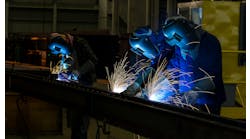Working in research and manufacturing for food and agricultural giant Cargill Corp. for more than a quarter century, Jack Starr saw firsthand the challenges of trying to scale innovation. Projects were stalled or canceled because specialized equipment and facilities just weren’t available in the United States.
Starr spent 15 years as a research and development director at Cargill, working on process control and simulation and advanced analytics. Later, as a leader in Cargill’s smart manufacturing program, he ran interdisciplinary teams developing and deploying new technologies for Cargill and partner factories. He also led a process development effort in biomanufactured plastics for NatureWorks, a Cargill joint venture with Thailand-based PTT Chemical. That effort led to the construction of a lactic-acid plant to supply raw materials for the renewable plastics’ production.
Ready for a new challenge, earlier this year Starr left the private sector to take the chief manufacturing role at BioMADE, a new Manufacturing Institute that aims to bridge the innovation gap, encourage reshoring and build a more resilient biomanufacturing supply chain. There, he is tasked with overseeing the site selection, design, construction and operations for a network of pilot-to-intermediate biomanufacturing facilities throughout the country, starting with the first site in Minnesota.
Starr spoke with IndustryWeek about the hurdles for biomanufacturing in the U.S. and how BioMADE intends to change the equation.
IndustryWeek: You were head of R&D at Cargill and have also led the process engineering space for R&D. What made you choose to leave and take a more public-sector role?
Jack Starr: The role encompassed a lot of what I've done in the past in terms of piloting plus building teams, building capabilities. But it also intrigued me in the sense that BioMADE has a very holistic view. It addresses the need for scale of facilities within the U.S., and also the idea of the whole education and workforce development part of it—that we have a strong technology and innovation base that is looking at how to be more effective and efficient in our bioprocessing.
Safety, security, sustainability and social responsibility are at the forefront of our goals. We see the sustainability aspect in a wide variety of the products that are coming to market.
Were you aware of the scale-up issues when you were at Cargill?
Yes. The lack of scale-up and process development facilities in the United States has likely hindered the overall growth of the industry. I personally lived through this when I was involved with the NatureWorks business. NatureWorks is a Cargill joint venture that makes [polylactic] acid. To do that, you take corn sugars to produce lactic acid, and then that lactic acid is then further polymerized to make PLA.
I was highly involved with the process development and piloting before the plant was built. We were working with two very large companies in the joint venture. We struggled to find the right equipment across the United States in order to be able to pilot this effectively. And so I have lived that, and that was another reason why I was excited to work in a different dimension compared to Cargill. I'm working on a larger impact for the industry as a whole. Our members want to take benchtop processes and bring them to fruition at a commercial scale.
I also had two other big roles in Cargill, or big in the sense of the time that I was in those roles. I led our process development and piloting. I was running a facility and looking at changes, like step changes as well as incremental changes in improving our manufacturing base at Cargill. And then I was leading our process engineering and analytics team that was pointed towards our manufacturing and operations.
I am bringing skills like process modeling, process control, advanced analytics, all to our manufacturing base, again to be able to drive better performance within our manufacturing. We’re able to bring industry standards very quickly into our piloting space to show our members who maybe are building their first plant: This is what a scale-down of a manufacturing plant should look like.
You were talking about companies unable to get the equipment needed to scale up their startup projects. Is this a United States problem as far as competitiveness? Are there other countries that are ahead of us on this?
The lack of piloting facilities for fermentation and downstream processing has been a longstanding problem. The European Union has created a facility and a network of facilities, multiple facilities, that show how this type of a partnership can work.
Are there certain projects that will be priorities?
A key aspect of BioMADE is within our technology, innovation space. Those projects are smaller scale at this point. But there are some that are very relevant to our manufacturing: What is the best design for a fermenter? How do we improve that fermenter design because that is where a lot of capital expense goes? If we're able to have a better designs, we're able to be more productive with our capital dollars. And also, there are a number of projects around improving the downstream concentration and purification of those fermentation products. Those innovations can potentially then be deployed in our in our pilot database.
What are the possibilities of fermentation beyond what’s already being done?
There has been huge work in biotechnology research on how to adjust microorganisms so that they can make a wide variety of products. That has really catalyzed the bioindustrial ecosystem. And so, there's lots of different things we can make. It could be monomers that are going to be then converted to polymers. It can be high molecular-weight polymers themselves. We are seeing then the products of fermentation can go into just a wide variety of things—clothing, fabrics, food packaging and other packaging, and for everyday materials, some are looking at beauty products. There's been a lot of interest in protein from fermentation. And so those are some of the more non-traditional things that have really come up in the last five to 10, 15 years as we've been able to build new pathways
When I looked at your website, I saw one project that involved making natural rubber with microorganisms. And another had Lockheed Martin Corp. partnering with a fermentation company.
Yeah, so you're talking about two projects that I know a little bit about. In the case of Lockheed, they are the potential downstream user, or purchaser, of these products. That’s one aspect of building that whole ecosystem, all the way from farmers who are growing our feedstocks, to the people who are processing, to those corn sugars. Traditionally, it's corn sugars to other products, and then people who will buy those products. You need everybody involved for the technology and the business to be successful.
This is one of the positives in the whole U.S. economy. A strong biomanufacturing ecosystem helps our farming communities and rural communities, strengthens these economies. A lot of these processing facilities could end up in the world just as we've seen ethanol plants dotted across the Corn Belt. And then if you look at the broader role of agriculture, it’s very important for our success.
The overarching plan is for 12 to 15 pilot plants. Where will these plants be?
We have a grand vision of 12 to 15 facilities. Right now, with the federal funding, we have an expectation of local and state funding. We think we can have two or three facilities built out depending upon how big they are. We’ve already had an announcement on the Minnesota site, and we're very moving forward on site selection. Site selection is a very complex process. You're navigating utility requirements, zoning requirements, various environmental permits. That has been a learning curve for me. But as we look at the broader vision of BioMADE, we foresee a nationwide network with different capabilities because our members have different needs. And other stakeholders like the U.S. government and the Department of Defense—they also have a stake in in what we're doing.
If you're doing regional biotechnology hubs, regions have different feedstocks. These will all come into play as to the purpose of the facility and where it's located.
Why did you choose Minnesota for the first site?
We have strong membership across the entire Corn Belt. The state of Minnesota has a lot of elements that are very favorable to running biomanufacturing. They've got strong agricultural systems, particularly in the southern portion of the state, and they have a strong educational system around the STEM system.
Traditional biomanufacturing looks at corn, sugars and nontraditional downstream processing. That will likely be the focus at the Minnesota site, as well as the larger equipment that's needed to scale up.
We will be purchasing equipment like fermenters and tanks and various downstream processing, and those will be readily available to our members to come and use at that facility. Because it is very costly to build these and most of the companies cannot justify building it. For biomanufacturing, you need to marry the micro-performance with the equipment performance. And in terms of the fermenter, that's what you're really trying to understand as you go from the benchtop to commercial.
We generally know how to design a fermenter, but each micro-organism has specific needs. So you're gonna have to tailor some of the design of the fermenter to that particular microorganism. Same with the downstream processing. Most of these processing steps are well-known, but you have to tailor it to the exact nature of the [microorganism] and the product that you are processing.
What do you see as your biggest challenges?
We've got a complex number of stakeholders. We've got members who are different stages of their product development. You got some like startups that are small, intermediate size. We've got large multinationals. We've got academic institutes that we're pulling together for education and workforce development. We've gotten government organizations, NGOs, that are also very interested in the success of biomanufacturing in the United States. We've got vendors who will provide the equipment. We've got investors who are interested in these companies. So I think the complexity and the challenge is to align all these stakeholders to a common biomed mission. And move the industry forward.




